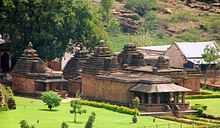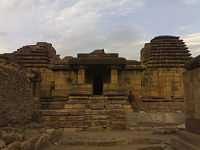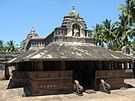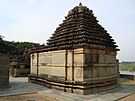Kadamba architecture
Kadamba architecture was a style of temple architecture founded by Mayurasharma in 4th century AD in Karnataka, India[1] Kadambas created new style of architecture which was the basis of the Hoysalas style of architecture, developed original school of sculpture, was the forerunner of series of South Indian sculptors.[2] Many temples at Aihole, Badami and Hampi are built in Kadamba architectural style.
History
During 345 AD to 525 AD, the ancient royal dynasty of Karnataka, the Kadambas made early contribution to the Architecture of Karnataka and they are the originators.[3]
Kadamba Shikara
The most prominent feature of Kadamba architecture was Shikara called Kadamba Shikara. The tower rises in steps without any decoration (pyramid shaped shikara)with pinnacle (Stupika or Kalasha) on top. The Kadamba temples vimana usually square in plan, the tower is pyramidal shape and constitutes a series of horizontal step stages decorated with uniform series of quadrangular vertical projections and covering vestibules attached to vimana, The stages are more numerous and less elevated, devoid of pavilion ornamentation.
Kadamba's architecture and sculpture contributed to the foundation of Chalukya-Hoysala style.
- Lakshmi Devi temple, Doddagaddavalli
- Bhoo Varaha Laxmi Narasimha Temple Halasi
Temples in Kadamba architectural style



The 5th century monuments at Halasi are the oldest surviving Kadamba structure. The most prominent feature is the Kadamba Shikara with a Kalasa on top. In Belgaum district, Hattikeshwara, Kalleshwara and Someshwara temples at Halasi and group of temples at Kadaroli illustrates the Kadamba architecture. The old Jain basadi containing a sanctum and a sukanasi at Halasi the most ancient stone temple in Karnataka. Kadamba architecture constituted an important link between the Shatavahanas, Pallavas and Chalukyas architecture. Kadamba architecture elements in Hoysala Architecture.[4]
Many temples at Aihole including Ramlingesvara temple Complex, Badigergudi temple and small shrines at Durga temple complex, Tryambakeshwara temple complex, ruined temple at Mallikarjuna temple complex, shrines at Jyotirlinga temple complex, small temple at Hucchimalli temple complex, ruined temples Galaganatha temple complex and many temples along the Malaprabha River are built in Kadamba architectural (Shikhara) style.
Kadamba style Mallikarjuna group of temples and Bhutanatha group of temples(temple on adjacent small hill top) at Badami.
Including Jain temples and two Shiva temples and many ruined temples on Hemakuta hill at Hampi built in Kadamba style of architecture.
- Mahakuta
There are many shrines with Kadamba superstructure at Mahakuta including Bhimeshwara ling temple, newly renovated temple out side main temple complex.
- Bandalike
There are many temples and Basadis at Bandalike (Bandalika), it is about 35 km from Shikaripura including Shantinath basadi, Sahasralinga temple and Someshwara threemurthy temples those are of Rastrakutas and Kadambas period, temples built in Kadamba style of architecture.
- Belgaum district
- Kamala Narayana Temple, Degaon (Degamve / Devgram)
- The Ruined temple at Konnur is 4 km from Gokak falls.
- Kamala basadi[5] at Belagavi
- Bhutnath temple Torgal (Torgal Fort) near Munvalli in Belgaum district.
- Panchlingeshwara Temple Munavalli Belgaum district has Kadamba shikhara.
- Ramalingaeshwara temple at Bailhongal
- There are few ruined temples at Hooli with Kadamba shikhara.
- The ruined temple beside the river at Kadaroli has the Kadamba style shikara.
- Temples at Halasi and Ramtheerth temple a top of the hill near Halasi
- Uttara Kannada district
- Including Madhukeshwara temple and Parvati temple many other temples at Banavasi has Kadamba style architecture (Shikhara).
- Ratnatraya Basti at Bilgi a small village near Siddapura, Uttara Kannada district of Karnataka.
- The 12th and14th century AD Shankara Narayana temple at Haliyur and Venkataramana Swamy temple at Muttinkere near Sonda in Sirsi taluk of Uttarkannada district.
- Mallikarjuna Temple at Haliyal.
- Hassan district
- Yoga Narasimha temple at Holalu in Hassan district
- The Kadamba Bettada Byreshwara Shiva temple built in black stone near Hanbal a hill station of Sakleshpur (in Western Ghats) in Hassan district.
- The Kadamba style Keerthinarayana temple is at Heragu in Hassan district.
- Gadag district
- The old Jain temple at Lakshmeshwara has Kadamba shikara.
- Trilingeshwara temple at Hosur in Gadag district
- Narasimha temple Gadag, veera narayana temple complex Gadag
- Haveri district
- The Kere Someshwara Temple at Kalakeri in Hangal taluk of Haveri district,[6] is in Kadamba style architecture (Shikhara).
- Basavann Temple in the Chaudayyadanapura Mukteshwara temple complex, Haveri District.
- Narasimha temple Narasapura near Chaudayyadanapura, Haveri District.
- Veerabhadra temple Hale Honatti in Ranebennur taluk of Haveri district
- Chikmagalur district
- The Kadamba style Bhairaveshwara Temple at Bhairapur, 22 km from Mudigere (in western ghats) in Chikmagalur district near to Kukke Subramanya.
- Prasanna Rameshwara Temple Devarunda, Mudigere in Chikmagalur district
- Malahanikareshvara, Bhavani temples shringeri.
- Other parts of Karnataka
- The 12th century AD Shiva temple at Udri Shimoga [7] built in Kadamba style architecture.
- Mallikarjuna Temple and Neelakanteshwara Temple, Kalasi
- Tryambakeshwara temple (Trikutachala) with Kadamba Shikhara at Kavital in Manvi taluk in Raichur district.
- Jain temple at Brahmagiri hill in Chitradurga district.
- Other parts of India
- Maharashtra
- Panchaganga Temple at Kolhapur built in Kadamba style.
- Mahabaleshwar Temple, Krishnai Temple Mahabaleshwar in Maharashtra
- Kaneri math kadamba style is in Karveer tehsil in Kolhapur district in Maharashtra
- Andhrapradesh
- Temples at Srisailam built during Vijayanagara empire (by Harihara Raya) has Kadamba Shikhara.
- Papanasi group of temples at Alampur in Andhrapradesh are built in Kadamba style architecture.
- Chaya Someshwara temple at Panagal in Nalgonda.
Chalukya-Kadamba architectural style
| Architecture of Karnataka |
|---|
| Architecture of Karnataka (345 to present) |
| Kadamba architecture – synthesis of several schools (345 to 525) |
| Dravidian architecture (Western Ganga Dynasty) (350 to 550) |
| Badami Chalukya architecture or the Vesara style (543 to 753) |
| Dravidian & Rekhanagara architecture of Rashtrakutas (753 to 973) |
| Western Chalukya architecture (Gadag style of architecture) (1000 and 1200) |
| Hoysala architecture of the Hoysala Empire (1100 and 1400) |
| Vijayanagara architecture of the Vijayanagar Empire (1336 to 1648) |
| Islamic architecture of Bijapur Sultanate (1490 to 1686) |
| Keladi Nayaka architecture of the Nayaka kingdoms (1499 – 1763) |
| Architecture of Kingdom of Mysore – Blends of Hindu, Muslim, Rajput, and Gothic styles of architecture (1399 to 1947) |
| Indo-Sarcenic and Muslim architecture of Tippu Sultan (1780) |
| Buddhist Viharas, Tibetan Culture & Tibetan architecture at Bylakuppe (1953 to present) |
| Sikh architecture of Bidar & Bangalore (1512 to present) |
| Neo-Gothic church architecture (1933 to 1956) |
| Neo-Dravidian architecture (1947 to present) |
- The Uma Maheshwara temple[8] at Hosagunda in Sagar taluk of Shimoga district.
Hoysala-Kadamba architectural style
- Aghoreshwara Temple at Ikkeri
- Late Hoysala Trikutachala temple built in granite has Kadamba Nagara sikhara.[9]
- The Eshwara Temple at Malali (Holenarasipura Taluk) in Hassan district in Karnataka, an early Hoysala structure with Kadamba Nagara style shikara.
- Lakshmi Devi temple, Doddagaddavalli built by Hoysala.
Kadamba-Yadava architectural style
Temples with this style
- Ananta Vasudeva Temple
- Champakesvara Siva Temple
- Lingaraja Temple
- Mangalesvara Siva Temple
- Purvesvara Siva Temple
- Rajarani Temple
- Yameshwar Temple
- Mahavinayak Temple
- Baladevjew Temple
See also
- Hindu temple architecture
- Architecture of Karnataka
- Badami Chalukya Architecture
- Gadag style of Architecture
- Karnata Dravida architectural style of Rashtrakuta
- Karnataka Dravida architectural style
- Hemadpanthi and Hemadpant
- Sikhara
- Halasi, Hangal, Banavasi
- Kadaba (of Dakshina Kannada), was capital of Kadamba Dynasty
Gallery of Kadamba Shikhara
Hemakuta temple hill complex Hampi
| Photo Gallery |
|---|
|
References
- ↑ "Kadamba Style Temple Architecture". Retrieved 2011-07-22.
- ↑ The Kadamba Kula A History of Ancient and Mediaeval Karnataka Reprint Bombay 1931 Edition -Preface. by George M. Moraes, H. Heras S.J.(Asian Educational Services). Retrieved 2013-08-26.
- ↑ "Kadambas of Banavasi". Retrieved 2011-07-22.
- ↑ "Kadamba Architecture - Banavasi". Retrieved 2013-08-23.
- ↑ "Kamal Basti has Kadamba Nagara shikara". Retrieved 2013-08-23.
- ↑ "Six chosen for development as ‘Heritage Cities’ in State". Retrieved 2013-09-03.
- ↑
- ↑ "Renovation work of Uma Maheshwara temple begins". Retrieved 2013-08-27.
- ↑ "CHANNAKESVA TEMPLE TOGETHER WITH ADJACENT". Retrieved 2013-08-27.
- ↑ "Goa - Tambdi Surla Temple - Kadamba-Yadava architecture". Retrieved 2013-08-23.
| ||||||||||||||||||||||||||||||||||||||
| ||||||||||||||||||











